I decided to head over to City Hall Park, and the area immediately surrounding it, to look at the lampposts. But as usual with this stuff, it turned into something more.
A little history first. As with many of New York City’s parks south of 59th Street, the park had military connections in its early yearsand was used as a cemetery for awhile. During the Dutch colonial era it was a commons, or an area used for public recreation (as in the Boston Common). After the British took over in 1664, things took a darker turn. The first execution by hanging took place in the former commons in 1691, and the first almshouse (the medieval equivalent of a retirement home, though decidedly less pleasant) was built here in 1735. In the subsequent decades the British used the commons for military parades and in 1757 a prison was built on the grounds.
As the city gradually moved northward the commons also found public uses, including opposition to British rule. Between 1766 and 1770 five “Liberty poles,” erected in sympathy to the patriotic cause, were raised in the commons but all were soon torn down by the British troops and loyalists. During the Revolutionary War, prisoners of war were ensconced in the prison and an additional one called Bridewell (see below).
After the war was won, the commons again became a public area. The site was chosen for New York’s new City Hall in the first decade of the 19th Century, replacing an older one at Wall and Nassau Streets. The new City Hall was designed by Joseph Mangin and John McComb and opened in an area many considered far removed from NYC’s business district. In fact, cheaper materials were used for the facing in the rear of the building facing Chambers Street.
The southern end of the park was home to New York’s central post office between 1867 and 1910 in a building several critics of the period considered to be an ugly monstrosity; it was finally torn down in 1939, and the junction of Broadway and Park Row was again open to the air. It still is, though it’s one of Manhattan’s most crowded and horn-honkingest intersections.
To get to City Hall Park I took the #2 train to Chambers Street. When you exit on the east side of the street you have a view of the 12-story Gerken Building on the SW corner of West Broadway. I know little about it other than it was built in 1899, and the World Wide Web seems to be silent about it. From the inscription above the front door, it used to contain offices of the New York National Exchange Bank, which, as the handy dandy Scripophily New York Bank History site informs us, was established in 1851 and after a series of mergers, became part of the Bank of New York in the 1980s.
In 1899, architects were beginning to shuck off the excesses of Beaux Arts and began to build more streamlined structures — the trend continues today. In 1899, though, a wide range of ornamental touches were still being added to new buildings. Check out the “G” shields that appear on the chamfered, or angled, edge of the building above the third floor; notice the ornamental floral additions. Also notice the very narrow bit of horizontal blue bricking. The architects added it knowing only serious buffs would notice it decades hence!

On the left at 124 Chambers, the Ecco Italian restaurant appears to have restored a 1940s-era sidewalk sign, although it might be a reasonable facsimile. Next door, the Mudville 9 Saloon takes its name form the classic 1888 poem “Casey at the Bat” by Ernest Thayer: The outlook wasn’t brilliant for the Mudville nine that day…

Almost at Church Street we find The Patriot at 110 Chambers. As a 2016 Yelp review says,
There were two employees working. A worthless door person who didn’t lift a finger, and a bartender who simply kicks ass! This lady handled the bar like no other. She was running from end to end. Clearing tables, pouring drinks and personable to EVERY customer. She said hi to every person who walked in and bye to everyone who left.
A few years ago, I led a ForgottenTour across the Manhattan and Brooklyn Bridges on a hot day in June. By tour’s end I was ready to drink the Atlantic Ocean. As it happened two of my cousins were in town, Johnny from LA and Moya from Vancouver and they met me after the tour. We found the Patriot and drank the afternoon away. The barmaid was chatty and friendly. Great for business — I must have had five drafts. The amazing thing was I was slightly buzzed but not nearly drunk on no lunch, while at other times, just two have me feeling it quite distinctly, lunch or no lunch. Question: did all that walking temporarily immunize me from drunkenness? If you have an answer, let me know at kevinjudewalsh@gmail.com. (The cousins and I then went out to another cousin’s house in New Hyde Park for more drinks.)

The Cary Building, on the corner of Church and Chambers, is a cast-iron front structure completed in 1857 in the Italianate style, and originally housed a dry goods store, Cary, Howard and Sanger. Like the Gerken Building on West Broadway it was converted to luxury residences a number of years ago.
On the northwest corner of Chambers and Broadway stands a former department store and newspaper headquarters. The massive structure was built in 1846 for Scottish department store magnate A.T. Stewart, whose dry goods emporium was located in the building. From 1919 to 1950 it was home to The New York Sun newspaper, famed for its “Yes, Virginia” editorial and for the 1835 Great Moon Hoax.
The newspaper’s 1919 copper-faced clocks are still in place on the corners of Broadway and Chambers and Reade with its motto, The Sun Shines for All. The Sun had a shortlived revival on newsstands in the 1990s, but remains as an online entity.
Behind the fence surrounding City Hall Park facing Broadway between Murray and Warren Streets is a very low brick wall marking the boundaries of what used to be the Bridewell (taking its name from a British prison), constructed in 1775, the place in which the British kept American prisoners of war during the city’s occupation, which didn’t end until 1783. British treatment of what they considered traitors was typically brutal; the Bridewell was unheated and meals were irregular. William Cunningham, the British provost marshal, made a deathbed confession that he had starved prisoners and had executed 275 prisoners including, some say, Nathan Hale.
Even after the Revolutionary War was over, the Bridewell was used as a jail until the new penal complex known as the Tombs was completed uptown in 1838. Its cornerstone is on display at the New-York Historical Society.
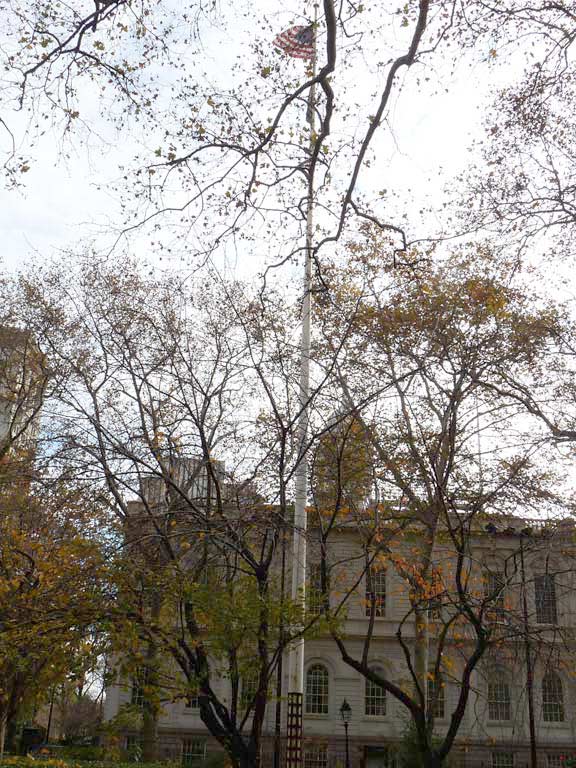
“Liberty poles” were commonly erected during the Revolutionary era. They were meant to inspire pride but they also had a practical inspiration: when a red flag, called an ensign, was raised, it was a call for townspeople or organizations such as the Liberty Boys or the Sons of Liberty in Vermont to meet and express views regarding British rule. Needless to say the British kept cutting them down, and patriots kept re-raising them.
The liberty pole in what became City Hall Park was raised in 1767 to protest the Townshend Act, which taxed paper, glass and tea imports, among other items. The British sawed it down in January 1770, were then attacked by patriots, and a counterattack by the British led to a battle on nearby Golden Hill (remembered today by Gold Street).
This 66-foot tall replica of the sawed-off liberty pole was installed in 1921, a gift of the Sons of the Revolution and the New York Historical Society. A weathervane shaped into the word “Liberty” was placed at the apex, as the one in the Revolutionary era was. Iron bands at the base also hark back to original protections.
Another such liberty pole can be found on 18th Avenue and 83rd Street in Bensonhurst; see the end of FNY’s New Utrecht Avenue page for a look at that one.
In 2000, Broadway, Park Row and Chambers Street on sides facing City Hall Park received these new, massive versions of NYC’s traditional Twinlamp design. These designs hark back to the original Type 1 Twins installed on 5th Avenue beginning in 1892, especially in the masts. The scrollwork resembles a lyre, and the top of the shaft connects with the mast at a spheroid ornament. There are other sorts of rich detailing present in the 1892 posts such as star and spring-shaped baubles.
Of course these new Twins are decked out with security camera belonging to the NYPD and other law enforcement entities in the age of terror.
I’d like a simpler design based on the original 1892 posts to be reinstalled on a new set of 5th Avenue Twins. In 1965, a special-edition Twin Deskey began to replace the Type 1 Twins, but over the years, most of those have also disappeared. 5th Avenue deserves its own specialized set of lamps once again, and this design fits the bill.
Speaking of Deskeys…

It was in 1958 that the very first Donald Deskey designed street lamp first appeared on the corner of Broadway and Murray. This one, a block away at Warren, was probably not installed as part of that first batch. This model started being installed en masse in NYC streets in 1962, but new numbers haven’t appeared since the 1970s. Its reign was brief, but dominant.
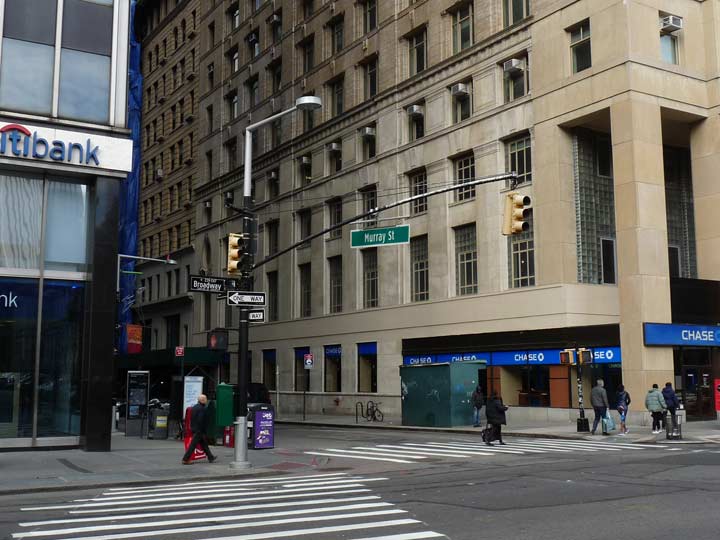
And speaking of Broadway and Murray, this is the corner where that Deskey first appeared. About 15 years ago it was replaced, as were most posts on Broadway from the Battery north to City Hall Park, by a streamlined, L-shaped-gray and black Downtown Alliance streetlamp. The Alliance is a business improvement district representing lower Manhattan including the Financial District. They have also installed a new set of black and white street signs that I think should become the standard all over the city.
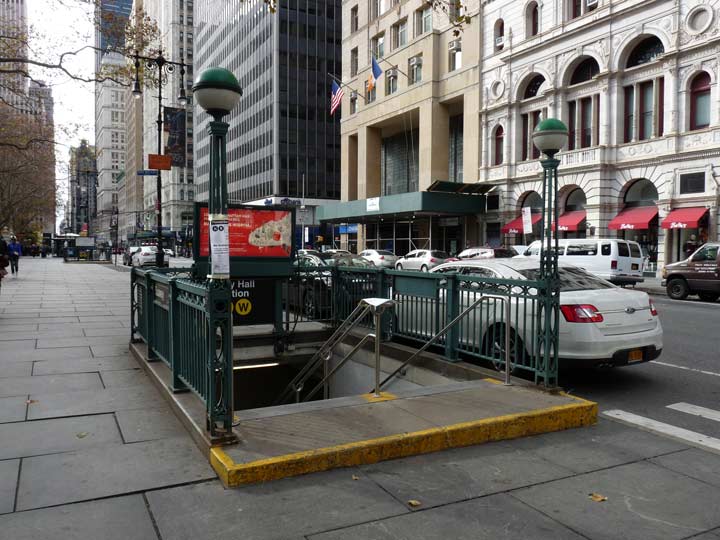
Even the entrance to the BMT City Hall station, home to the R, W and sometimes N trains, receives something of a deluxe treatment with fancier station gates and light stanchions, even though this is a regular local stop.
If you descend to the platform, it appears to be an express stop with a central platform and a lower level. However, that lower level is only used to store idle trainsets and doesn’t connect to the express tracks that come off the Manhattan Bridge at the next stop to the north, Canal Street.
Of course the BMT City Hall station shouldn’t be confused with the closed IRT City Hall Station, which was NYC’s first when it opened October 27, 1904. The BMT City Hall station opened 8 years later and already, a somewhat more austere design esthetic had set in.
Interestingly, when the BMT was being run through here in 1912, it supplanted a much earlier subway line constructed by Alfred Ely Beach in 1870 that ran by driving air to run it. Such pneumatic systems have been used to deliver mail in office buildings for years, and Beach ran the line under Broadway using one subway car between Murray and Warren Streets. Running only one block, it was supposed to be an exhibition of what a pneumatic system could do it it were to be expanded. However, a true pneumatic train system has never been developed. A stock market crash in 1873 and the opposition of William M. “Boss” Tweed, among other factors, were reasons for its abandonment. All traces of the Beach line were eliminated during BMT construction.
However: in 1976, interest in the Beach pneumatic line was again temporarily revived by the pop group Klaatu’s recording “Sub-Rosa Subway.”
Two different philosophies in kiosk design, one going back to early subway design and the streamlined style of the late 20th and early 21st Century.
A demolition on Park Row has allowed a view of the west side of #5 Beekman Street (Temple Court), which has been called one of NYC’s lost treasures. Completed in 1883, it joins the Potter Building as an early adopter of fireproof building methods. Amazingly, its nine-floor atrium with cast-iron balustrades was completely abandoned for many years. It’s being redeveloped now as a hotel, after many years of neglect. The building was built by banker/Irish immigrant Eugene Kelly, who had amassed the nineteenth-century equivalent of $630 million by the time he died.
Many of New York’s foremost urban photographers have been granted access to the amazing atrium and have produced photos of this space that are truly incredible.
As a new tower rises on Park Row, this exterior view will eventually no longer be available.
In Part 2: City Hall Park and Nathan Hale
12/25/16

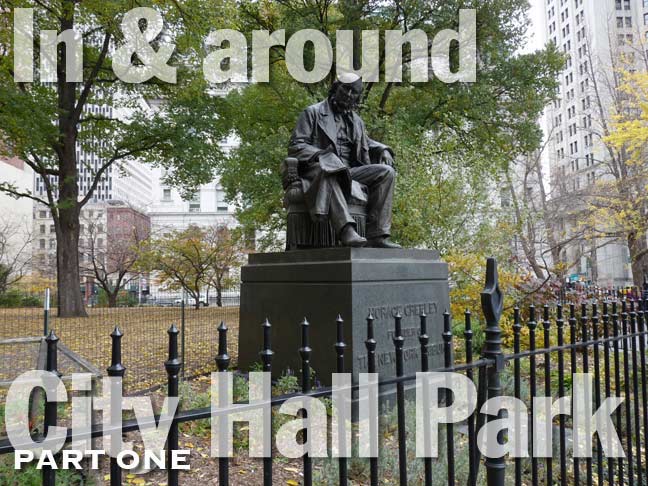
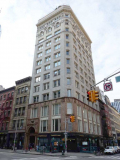


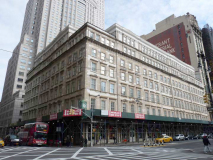
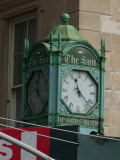
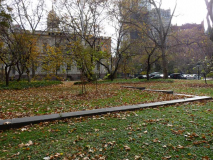

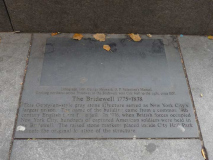
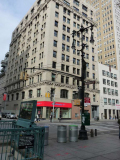
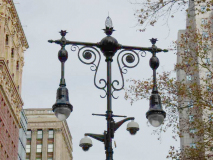
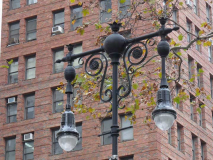
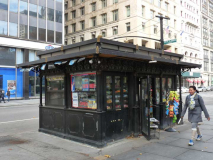
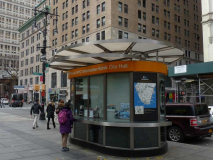
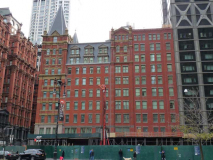
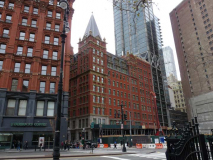
1 comment
The A.T. Stewart Dept Store building is on the northeast corner of Chambers and Broadway, n’est pas?